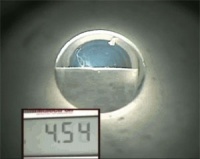Researchers at NASA’s Langley Research Center, the US Department of Energy’s Thomas Jefferson National Accelerator Facility and the National Institute of Aerospace created a new technique to synthesise the boron-nitride nanotubes (BNNTs). They are highly crystalline and have a small diameter. They also structurally contain few walls and are very long.
‘Before, labs could make really good nanotubes that were short, or really crummy ones that were long. We’ve developed a technique that makes really good ones that are really long,’ said Mike Smith, a staff scientist at NASA’s Langley Research Center.
The synthesis technique, called the pressurised vapour/condenser (PVC) method, was developed with Jefferson Lab’s Free-Electron Laser and later perfected using a commercial welding laser. In this technique, the laser beam strikes a target inside a chamber filled with nitrogen gas. The beam vaporises the target, forming a plume of boron gas.
A condenser, a cooled metal wire, is inserted into the boron plume. The condenser cools the boron vapour as it passes by, causing liquid boron droplets to form. These droplets combine with the nitrogen to self-assemble into BNNTs.
Researchers used the PVC method to produce the first high-quality BNNTs that are long enough to be spun into macroscopic yarn, in this case centimetres long. A cotton-like mass of nanotubes was twisted into a yarn about 1mm wide, indicating that the nanotubes themselves are about 1mm long.
‘They are textile like,’ said Kevin Jordan, a staff electrical engineer at Jefferson Lab. ‘This means that you can use commercial textile manufacturing and handling techniques to blend them into things such as body armour and solar cells and other applications.’
Transmission electron microscope images show that the nanotubes are very narrow, averaging a few microns in diameter. TEM images also revealed that the BNNTs tended to be few-walled, most commonly with two to five walls, although single-wall nanotubes were also present. Each wall is a layer of material, and fewer-walled nanotubes are the most sought after.
The researchers say the next step is to test the properties of the new boron-nitride nanotubes to determine the best potential uses for the new material. They are also attempting to improve and scale up the production process.

Fibrils of boron-nitride nanotubes are formed through the pressurised vapour/condenser method. The nanotube fibrils are produced when the FEL laser beam strikes a target of pressed boron powder. The number indicates laser power level in arbitrary units; about 1.5kW in actuality. The target rotates to distribute the laser heat evenly




Nanogenerator consumes CO2 to generate electricity
Whoopee, they've solved how to keep a light on but not a lot else.